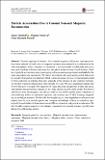Particle acceleration due to coronal non-null magnetic reconnection
Abstract
Various topological features, for example magnetic null-points and separators, have been inferred as likely sites of magnetic reconnection and particle acceleration in the solar atmosphere. In fact, magnetic reconnection is not constrained to solely take place at or near such topological features and may also take place in the absence of such features. Studies of particle acceleration using non-topological reconnection experiments embedded in the solar atmosphere are uncommon. We aim to investigate and characterise particle behaviour in a model of magnetic reconnection which causes an arcade of solar coronal magnetic field to twist and form an erupting flux rope, crucially in the absence of any common topological features where reconnection is often thought to occur. We use a numerical scheme which evolves the gyro-averaged orbit equations of single electrons and protons in time and space, and simulate the gyromotion of particles in a fully analytical global field model. We observe and discuss how the magnetic and electric fields of the model and the initial conditions of each orbit may lead to acceleration of protons and electrons up to 2 MeV in energy (depending on model parameters). We describe the morphology of time-dependent acceleration and impact sites for each particle species and compare our findings to those recovered by topologically based studies of three-dimensional (3D) reconnection and particle acceleration. We also broadly compare aspects of our findings to general observational features typically seen during two-ribbon flare events.
Citation
Threlfall , J W , Neukirch , T & Parnell , C E 2017 , ' Particle acceleration due to coronal non-null magnetic reconnection ' , Solar Physics , vol. 292 , 45 . https://doi.org/10.1007/s11207-017-1060-0
Publication
Solar Physics
Status
Peer reviewed
ISSN
0038-0938Type
Journal article
Rights
© The Author(s) 2017. This article is distributed under the terms of the Creative Commons Attribution 4.0 International License (http://creativecommons.org/licenses/by/4.0/), which permits unrestricted use, distribution, and reproduction in any medium, provided you give appropriate credit to the original author(s) and the source, provide a link to the Creative Commons license, and indicate if changes were made.
Collections
Items in the St Andrews Research Repository are protected by copyright, with all rights reserved, unless otherwise indicated.
Related items
Showing items related by title, author, creator and subject.
-
Nanoscale investigation of superconductivity and magnetism using neutrons and muons
Ray, Soumya Jyoti (University of St Andrews, 2012-06) - ThesisThe work presented in this thesis was broadly focussed on the investigation of the magnetic behaviour of different superconducting materials in the form of bulk (single crystals and pellets) and thin films (nanomagnetic ... -
The dynamic topology of the solar corona : mapping the Sun’s three dimensional magnetic skeleton
Williams, Benjamin Matthew (University of St Andrews, 2018-06-26) - ThesisObservations of the surface of the Sun reveal multi-scaled, mixed magnetic features that carpet the entire solar surface. Not surprisingly, the global magnetic fields extrapolated from these observations are highly ... -
Analytical three-dimensional magnetohydrostatic equilibrium solutions for magnetic field extrapolation allowing a transition from non-force-free to force-free magnetic fields
Neukirch, Thomas; Wiegelmann, Thomas (2019) - Journal articleFor the extrapolation of magnetic fields into the solar corona from measurements taken in the photosphere (or chromosphere) force-free magnetic fields are typically used. This does not take into account that the lower ...

